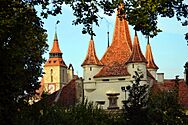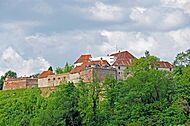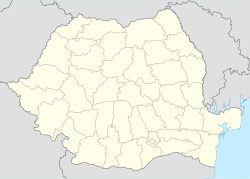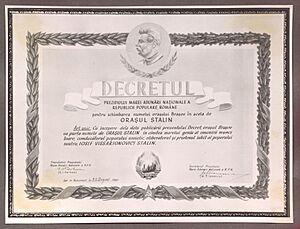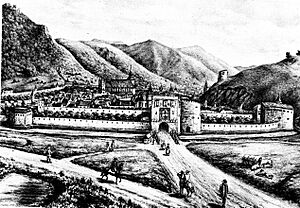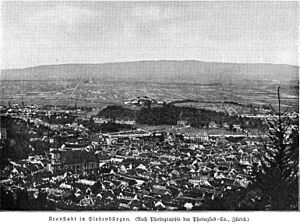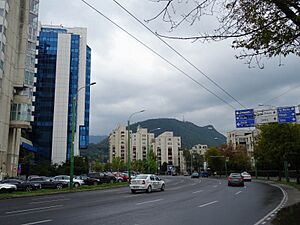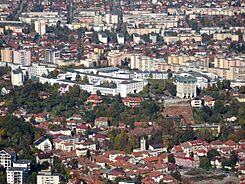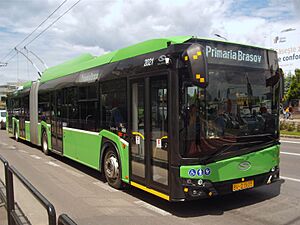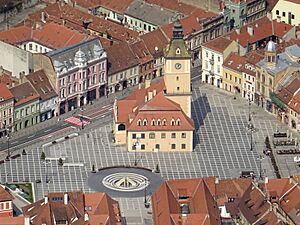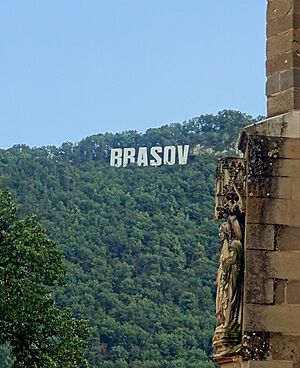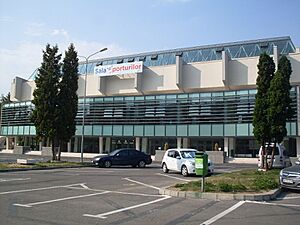Brașov facts for kids
Quick facts for kids
Brașov
|
|||
|---|---|---|---|
|
From top, left to right: Panoramic view of the Old Town, Republicii Street, Piața Sfatului (Council Square), Catherine's gate, Biserica Neagră (Black Church), Brașov fortress, Cetățuia de pe Strajă
|
|||
|
|||
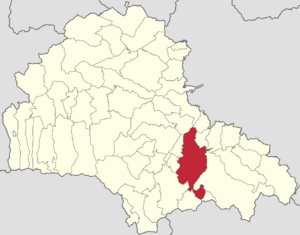
Location in Brașov County
|
|||
| Country | |||
| County | Brașov | ||
| Status | County capital | ||
| First mentioned | 1235 | ||
| Area | |||
| • Municipality | 267.32 km2 (103.21 sq mi) | ||
| • Metro | 1,368.5 km2 (528.4 sq mi) | ||
| Elevation | 538 m (1,765 ft) | ||
| Population
(2021 census)
|
|||
| • Municipality | 237,589 | ||
| • Metro | 371,802 | ||
| Demonyms | brașovean, brașoveancă | ||
| Population by ethnicity | |||
| • Romanians | 91.2% | ||
| • Hungarians | 7.9% | ||
| • Germans (Transylvanian Saxons) |
0.5% | ||
| • Roma | 0.4% | ||
| Time zone | UTC+2 (EET) | ||
| • Summer (DST) | UTC+3 (EEST) | ||
| Postal code |
RO 500xxx
|
||
| Area code(s) | (+40) 268 | ||
| Vehicle registration | BV | ||
Brașov is a city in Transylvania, Romania. It is the main city of Brașov County.
With over 237,000 people, Brașov is the 6th largest city in Romania. Its wider area, including nearby towns, has about 371,000 residents.
The city is in the middle of Romania, about 166 km (103 miles) north of Bucharest. It is surrounded by the Southern Carpathians mountains. Brașov is a key part of the historical region of Transylvania.
For a long time, Brașov was a very important trading city. It was a major stop on the trade routes between Austria and Turkey. The national anthem of Romania was also first sung here.
Contents
City Names: Brașov, Kronstadt, and More
Where Did the Name Brașov Come From?
The name Brașov might come from a local river called Bârsa. Over time, this name changed to Barsov and then to Brașov. Some experts think it comes from a Turkic word, barasu, meaning "white water."
The first time the name "Barasu" was written down was in 1252. Back then, it referred to the "Saxon Land of Baras."
Corona and Kronstadt: The Crown City
The name Corona means "crown" in Latin. It was first mentioned in 1235. Some believe it refers to a monastery. Others think it comes from the city's old coat of arms, which showed a crown.
The German name for the city is Kronstadt, which also means "Crown City." Both Kronstadt and Corona were used at the same time during the Middle Ages.
Orașul Stalin: A Temporary Name Change
Another historical name for Brașov was Stephanopolis, meaning "Crown City."
In 1950, Brașov was renamed Orașul Stalin, or "Stalin City." This was done to honor Joseph Stalin, who was the leader of the Soviet Union at that time. The city's name went back to Brașov in 1960.
A Look Back: Brașov's History
![]() Kingdom of Hungary 1235–1526
Kingdom of Hungary 1235–1526
![]() Eastern Hungarian Kingdom 1526–1570
Eastern Hungarian Kingdom 1526–1570
![]() Principality of Transylvania 1570–1711
Principality of Transylvania 1570–1711
![]() Grand Principality of Transylvania 1711–1804
Grand Principality of Transylvania 1711–1804
![]() Austrian Empire 1804–1867
Austrian Empire 1804–1867
![]() Austria-Hungary 1867–1918 (de jure Hungary until 1920)
Austria-Hungary 1867–1918 (de jure Hungary until 1920)
![]() Kingdom of Romania 1920–1947 (de facto from 1918)
Kingdom of Romania 1920–1947 (de facto from 1918)
![]() Romanian People's Republic 1947–1965
Romanian People's Republic 1947–1965
![]() Socialist Republic of Romania 1965–1989
Socialist Republic of Romania 1965–1989
![]() Romania 1989–present
Romania 1989–present
People have lived in the Brașov area for a very long time, since the Stone Age (about 9500 BCE). Scientists have found signs of ancient settlements in several places around the city. These include traces of old Dacian forts and even a Roman-style building.
The Role of Transylvanian Saxons
Transylvanian Saxons were German settlers who came to Transylvania between 1141 and 1300. Hungarian kings invited them to help build towns, open mines, and farm the land. They played a big part in Brașov's growth.
In 1211, the Teutonic Knights built a fort in the area to protect the border. They built Kronstadt, or 'the City of the Crown', where Brașov now stands. Even though the knights left by 1225, the settlers they brought stayed. They founded three separate settlements that later became Brașov:
- Corona, near the Black Church.
- Martinsberg, west of Cetățuia Hill.
- Bartholomä, on the eastern side of Sprenghi Hill.
Brașov as a Trade Center
The German people in Brașov were mostly traders and craftspeople. Because the city was located where important trade routes met, they became very wealthy. This also gave them a lot of power in the city. They built many of the beautiful buildings you can still see today.
The city was protected by strong walls and towers. Different groups of craftspeople, called guilds, were in charge of maintaining these towers. Some parts of the old walls and gates, like Catherine's Gate and Șchei Gate, are still standing. The city center has the old mayor's office building and the main square. The famous "Black Church" is also nearby.
In 1689, a huge fire destroyed almost the entire walled city. It took many years to rebuild it.
Different Communities in Brașov
Besides the German population, Brașov also had many Romanian and Bulgarian people living in the Șchei district. There were also some Hungarian people in the Blumăna district. The Romanian church and school in Șchei were very important for Romanian culture and religion. They received money from many rulers of Moldavia and Wallachia.
In the 1800s, Romanians in Șchei worked to gain more rights. They started the first Romanian language newspaper, Gazeta Transilvaniei, in 1838. They also opened the first Romanian schools of higher education.
By 1850, Brașov had about 21,782 people. About 40% were Germans, 40% Romanians, and 13% Hungarians. By 1910, the population grew to 41,056. At that time, Hungarians were the largest group, followed by Romanians and Germans.
Brașov in the 20th Century
During World War I, the Romanian Army briefly took over Brașov in 1916. However, German and Austro-Hungarian forces soon took it back.
After the war, in 1918, Transylvania joined Romania. Brașov officially became part of Romania in 1920. The city grew and became a lively place for business and culture.
After World War II, many ethnic Germans were forced to move to the Soviet Union. Later, many more moved to West Germany.
During the communist period, Brașov became a major industrial city. Many factories were built, and people from all over the country came to work here. In 1987, there was a big workers' strike in Brașov. The government stopped it very harshly, and many workers were put in prison.
Brașov's Economy
From Airplanes to Tractors
Brașov started to develop its industries between the two World Wars. One of the biggest factories was IAR Brașov, which made Romania's first fighter planes for World War II.
After the war, the factory started repairing trucks. In 1945, it began making tractors. The IAR 22 was the first tractor made in Romania. Later, the company became known as Universal Tractor Brașov.
Much of the old factory was taken down in 2013-2014 to make way for new buildings and a shopping mall. Airplane manufacturing started again in 1968 at a new location nearby.
Modern Industry
During the communist era, Brașov's industries grew very quickly, especially heavy industries. Today, Brașov still makes many industrial products. These include trucks, car parts, bearings, building materials, and tools. The city also produces furniture, textiles, and shoes. There is also a large brewery.
Geography and Climate
Brașov has a climate with warm summers and cold winters. The average temperature in July is about 18°C (64°F), and in January it's about -4°C (25°F). The city gets a good amount of rain, especially in summer.
People of Brașov
Brașov has a population of 237,589 people. Most residents are Romanians, making up about 91% of the population. There is also a significant number of Hungarians (about 7%) and a smaller number of Germans and Romani people.
The Brașov metropolitan area, which includes the city and its surrounding towns, has about 371,802 people.
City Government
Brașov is led by a mayor and a local council. The current mayor is Allen Coliban, who started his term in October 2020.
The local council has 27 members. The main political parties represented are the Save Romania Union (USR), the National Liberal Party (PNL), and the Social Democratic Party (PSD).
Education in Brașov
Brașov has many schools and universities.
High Schools
There are many high schools in Brașov, including:
- Colegiul Național "Andrei Șaguna"
- Colegiul Național "Dr. Ioan Meșotă"
- Colegiul Național de Informatică "Grigore Moisil"
- Colegiul Național "Unirea"
- Colegiul Național Johannes Honterus
- Colegiul Național "Áprily Lajos"
Universities
Brașov is home to several universities, including:
- Transilvania University of Brașov
- George Barițiu University
- Spiru Haret University
- Christian University Dimitrie Cantemir
Getting Around Brașov
Brașov has a good public transport system with many bus and trolleybus lines. These lines connect different parts of the city and also go to nearby areas like Poiana Brașov, a popular winter resort.
The Brașov railway station is one of the busiest in Romania. You can catch trains from here to most places in the country.
Brașov-Ghimbav International Airport
The Brașov-Ghimbav International Airport is a new airport located near Ghimbav. It is the first airport built in Romania since the end of communism. The airport opened for commercial flights on June 15, 2023. There are also plans to connect the airport to the Brașov railway station by train.
Tourism in Brașov
Brașov is a great place to visit in Romania. Its central location makes it easy to explore other tourist spots, like the Black Sea resorts or the famous monasteries in northern Moldavia. It is also the largest city in a mountain resort area.
You can take a cable car to the top of Tâmpa Mountain for amazing views of the old city.
Brașov is also popular for winter sports. Poiana Brașov is Romania's most famous ski resort. Brașov is the second most visited city in Romania, after Bucharest.
Popular Sights in Brașov
- Biserica Neagră ("The Black Church"): A famous Gothic church built in 1477. It got its name after a big fire in 1689 blackened its walls with smoke.
- Casa Sfatului ("The mayor's former office building"): This building was the city's administration center for over 500 years.
- Biserica Sf. Nicolae (St. Nicholas Church): This church dates back to the 14th century.
- The First Romanian School: A museum that shows the first Romanian printing press and other important historical items.
- The Rope Street: The narrowest street in Romania.
- Catherine's Gate: The only original city gate from medieval times that is still standing.
- Șchei Gate: Built in 1827, next to Catherine's Gate.
- Tâmpa: A small mountain in the middle of the city, offering great views.
- The "Brașov Citadel Fortress" – Cetățuia Brașovului: An old fortress that protected the city.
- The nearby Bran Castle: Often linked to the legend of Dracula.
- Poiana Brașov: A popular ski resort and tourist spot.
- Râșnov Fortress: A restored peasant fortress near the town of Râșnov.
- Prejmer Fortress: A fortified church in the nearby village of Prejmer.
Sister Cities
Brașov is twinned with several cities around the world, meaning they have friendly relationships and cooperate on different projects. Some of these cities include:
 Bijeljina, Bosnia and Herzegovina
Bijeljina, Bosnia and Herzegovina Cleveland, United States
Cleveland, United States Győr, Hungary
Győr, Hungary Holstebro, Denmark
Holstebro, Denmark Linz, Austria
Linz, Austria Musashino, Japan
Musashino, Japan Rishon LeZion, Israel
Rishon LeZion, Israel Tampere, Finland
Tampere, Finland Tours, France
Tours, France Trikala, Greece
Trikala, Greece
Sports in Brașov
Brașov has a long history in sports. The first sports clubs were started in the late 1800s. Today, you can practice many sports in Brașov, such as football, rugby, tennis, cycling, handball, skiing, and ice skating.
The city hosts several sports events every year, including tennis competitions and marathons. In 2013, Brașov hosted the European Youth Winter Olympic Festival. The city also bid to host the 2020 Winter Youth Olympics.
Local Sports Teams
- SR Brașov – a football (soccer) club
- ASC Corona Brașov – a club with women's handball and ice hockey teams
- CSU Brașov – a basketball team
Sports Venues
- Under construction
- Sala Polivalentă: A large indoor arena being built, with a capacity for over 10,000 people.
- Existing
- Silviu Ploeșteanu Stadium: A football stadium with 8,500 seats.
- Dumitru Popescu Colibași Sports Hall: An indoor sports hall for handball, basketball, and volleyball.
- Brașov Olympic Ice Rink: An ice rink used for ice hockey and public skating.
Media in Brașov
Brașov has several local newspapers, like Transilvania Express and Monitorul Express. There are also local TV stations, such as RTT and MIX TV.
Images for kids
-
Bran Castle (German: Die Törzburg), situated near Brașov
-
Black Church (German: Die Schwarze Kirche)
-
Catherine's Gate (German: Katherines Tor)
See also
 In Spanish: Brașov para niños
In Spanish: Brașov para niños





